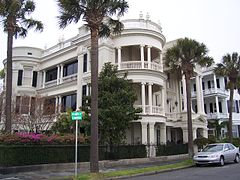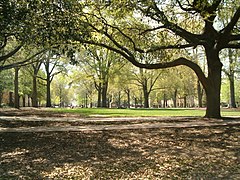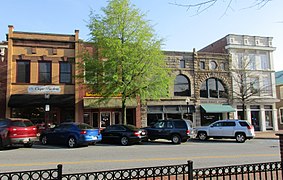Demographics of South Carolina

The U.S. state of South Carolina is located in the Southern United States. It is the 23rd largest state by population, with a population of 5,118,425 according to 2020 United States Census estimates.[1]
Demographics
[edit]| Census | Pop. | Note | %± |
|---|---|---|---|
| 1790 | 249,073 | — | |
| 1800 | 345,591 | 38.8% | |
| 1810 | 415,115 | 20.1% | |
| 1820 | 502,741 | 21.1% | |
| 1830 | 581,185 | 15.6% | |
| 1840 | 594,398 | 2.3% | |
| 1850 | 668,507 | 12.5% | |
| 1860 | 703,708 | 5.3% | |
| 1870 | 705,606 | 0.3% | |
| 1880 | 995,577 | 41.1% | |
| 1890 | 1,151,149 | 15.6% | |
| 1900 | 1,340,316 | 16.4% | |
| 1910 | 1,515,400 | 13.1% | |
| 1920 | 1,683,724 | 11.1% | |
| 1930 | 1,738,765 | 3.3% | |
| 1940 | 1,899,804 | 9.3% | |
| 1950 | 2,117,027 | 11.4% | |
| 1960 | 2,382,594 | 12.5% | |
| 1970 | 2,590,516 | 8.7% | |
| 1980 | 3,121,820 | 20.5% | |
| 1990 | 3,486,703 | 11.7% | |
| 2000 | 4,012,012 | 15.1% | |
| 2010 | 4,625,384 | 15.3% | |
| 2020 | 5,118,425 | 10.7% | |
| Source: 1910–2020[2] | |||
South Carolina's center of population is 2.4 mi (3.9 km) north of the State House in the city of Columbia.[3]
According to the United States Census Bureau, as of 2020, South Carolina had an estimated population of 5,118,425, which is an increase of 493,041, or 10.7%, since the year 2010.
According to the University of South Carolina's Arnold School of Public Health, Consortium for Latino Immigration Studies, South Carolina's foreign-born population grew faster than any other state between 2000 and 2005.[4] The Consortium reports that the number of Hispanics in South Carolina is greatly undercounted by census enumerators and may be more than 400,000.[4][5]
| By race | White | Black | AIAN* | Asian | NHPI* |
|---|---|---|---|---|---|
| 2000 (total population) | 68.88% | 30.01% | 0.69% | 1.13% | 0.10% |
| 2000 (Hispanic only) | 2.05% | 0.26% | 0.05% | 0.03% | 0.02% |
| 2005 (total population) | 69.12% | 29.68% | 0.69% | 1.31% | 0.10% |
| 2005 (Hispanic only) | 2.95% | 0.27% | 0.06% | 0.04% | 0.02% |
| Growth 2000–05 (total population) | 6.43% | 4.89% | 6.09% | 23.49% | 13.76% |
| Growth 2000–05 (non-Hispanic only) | 5.01% | 4.87% | 4.61% | 23.16% | 10.36% |
| Growth 2000–05 (Hispanic only) | 52.78% | 7.64% | 23.97% | 34.25% | 26.89% |
| * AIAN is American Indian or Alaskan Native; NHPI is Native Hawaiian or Pacific Islander | |||||
South Carolina’s population increased by 15.4 percent between 1990 and 2000 and by another 7.4 percent between 2000 and 2005; 11.6 percent of that increase has been attributed to immigration, primarily from Mexico and Latin America. Most work in the construction industry, with another proportion in agriculture, in addition to processing factories. The Latino population has increased considerably faster in South Carolina and the Southeast than for the United States as a whole.[6]
From 1720 until 1920, African slaves and their descendants made up a majority of the state's population. (See census data below.) Whites became a majority in the state after that date, following the migration of tens of thousands of blacks to northern industrial cities in the Great Migration. In the 21st century, most of the African-American population in the state lives in the Lowcountry and the Midlands areas, historically areas of their greatest concentrations of population.[citation needed]
6.6% of South Carolina's total population were reported as under 5 years old, 25.2% under 18, and 12.1% were 65 or older. Females made up approximately 51.4% of the population in 2000. Those who self-identify as having American ancestry are of mostly British Isles ancestry: English and Scots-Irish stock.[citation needed]
Birth data
[edit]Note: Births in table do not add up, because Hispanics are counted both by their ethnicity and by their race, giving a higher overall number.
| Race | 2013[7] | 2014[8] | 2015[9] | 2016[10] | 2017[11] | 2018[12] | 2019[13] | 2020[14] | 2021[15] | 2022[16] |
|---|---|---|---|---|---|---|---|---|---|---|
| White (NH) | 33,085 (58.2%) | 33,639 (58.4%) | 33,927 (58.4%) | 32,929 (57.4%) | 32,283 (56.6%) | 31,890 (56.3%) | 31,660 (55.5%) | 30,465 (54.7%) | 31,841 (55.7%) | 32,323 (55.9%) |
| Black | 18,591 (32.7%) | 18,598 (32.3%) | 18,577 (32.0%) | 16,527 (28.8%) | 16,851 (29.5%) | 16,681 (29.4%) | 16,802 (29.5%) | 16,309 (29.3%) | 16,009 (28.0%) | 15,333 (26.5%) |
| Asian | 1,235 (2.2%) | 1,293 (2.2%) | 1,289 (2.2%) | 1,134 (2.0%) | 1,125 (2.0%) | 1,172 (2.1%) | 1,155 (2.0%) | 1,148 (2.1%) | 1,167 (2.0%) | 1,176 (2.0%) |
| American Indian | 201 (0.3%) | 193 (0.3%) | 217 (0.4%) | 151 (0.3%) | 183 (0.3%) | 156 (0.3%) | 176 (0.3%) | 106 (0.2%) | 122 (0.2%) | 198 (0.3%) |
| Hispanic (of Native American race) | 4,411 (7.8%) | 4,646 (8.1%) | 4,942 (8.5%) | 5,135 (8.9%) | 5,221 (9.2%) | 5,255 (9.3%) | 5,741 (10.1%) | 5,993 (10.7%) | 6,386 (11.2%) | 7,073 (12.2%) |
| Total South Carolina | 56,795 (100%) | 57,627 (100%) | 58,139 (100%) | 57,342 (100%) | 57,029 (100%) | 56,669 (100%) | 57,038 (100%) | 55,704 (100%) | 57,185 (100%) | 57,820 (100%) |
- Since 2016, data for births of White Hispanic origin are not collected, but included in one Hispanic group; persons of Hispanic origin may be of any race.
- NH = Non-hispanic
Center of population
[edit]
Most populous counties
[edit]| County | Seat | 2000 Population | 2010 Population | 2017 Population |
|---|---|---|---|---|
| Greenville | Greenville | 379,616 | 451,225 | 506,837 |
| Richland | Columbia | 320,667 | 384,504 | 411,592 |
| Charleston | Charleston | 309,969 | 350,209 | 401,438 |
| Horry | Conway | 196,629 | 269,291 | 333,268 |
| Spartanburg | Spartanburg | 253,431 | 284,307 | 306,854 |
| Lexington | Lexington | 216,014 | 254,920 | 290,642 |
| York | York | 164,614 | 229,073 | 266,439 |
| Berkeley | Moncks Corner | 142,651 | 177,843 | 217,937 |
| Anderson | Anderson | 165,740 | 187,126 | 198,759 |
| Beaufort | Beaufort | 120,937 | 162,233 | 186,844 |
Cities and towns
[edit]-
Charleston – Columbus Street
-
Charleston – Atlantic Street at E. Battery Street
-
Columbia – USC Horseshoe – listed on National Register of Historic Places
-
Columbia – Skyline from Arsenal Hill
-
Spartanburg – Historical buildings on West Main
-
Greenville – Skyline by night
-
Greenville – Falls in Downtown area.
-
Hilton Head Island – Harbour Town
-
North Charleston – City Hall
Largest municipalities
[edit]Population estimates as of 2010.
- Columbia – 129,272
- Charleston – 120,083
- North Charleston – 97,471
- Mount Pleasant – 67,843
- Rock Hill – 66,154
- Greenville – 58,409
- Summerville – 43,392
- Sumter- 40,524
- Hilton Head Island – 37,099
- Florence – 37,056
- Spartanburg – 37,013
- Goose Creek – 35,938
- Aiken – 29,524
- Myrtle Beach – 27,109
- Anderson – 26,686
- Greer – 25,515
- Greenwood – 23,222
- Mauldin – 22,889
- North Augusta – 21,348
- Easley – 19,993
City and MSAs
[edit]South Carolina's metropolitan statistical areas (MSAs) are much larger than their central city population counts suggest. South Carolina law makes it difficult for municipalities to annex unincorporated areas, so city proper populations look smaller than is reflected in the total metropolitan populations.
For example, Myrtle Beach has a municipal population of less than 50,000 persons, but its MSA has more than 200,000 persons. Anderson's municipal population is smaller than Sumter's, but the Anderson MSA is larger, as seen below.
Columbia, Charleston, and Greenville all have urbanized area populations between 400,000 and 550,000, while their metropolitan statistical area (MSA) populations are each more than 600,000. The Greenville-Spartanburg-Anderson MSA population consists of approximately 1.4 million people, making it the largest in the state and third largest in the Carolinas.
Urban Area Population
[edit]As of 2010:[17]
- Columbia – 549,777
- Charleston/North Charleston - 548,404
- Greenville – 400,492
- Myrtle Beach – 215,304
- Spartanburg – 180,786
- Mauldin/Simpsonville - 120,577
- Rock Hill – 104,996
- Florence – 89,557
- Anderson – 75,702
- Sumter – 73,107
- Hilton Head Island - 68,998
Religion
[edit]
South Carolina residents are majority Protestant Christian, with a lower percentage of people claiming no religious affiliation than the national average. The religious affiliations of the people of South Carolina are as follows:
- Christian: 78%
- Protestant: 65%
- Evangelical (e.g., Southern Baptist Convention): 35%
- Mainline Protestant (e.g., United Methodist Church): 15%
- Historically Black (e.g., African Methodist Episcopal Church):[clarification needed] 15%
- Roman Catholic: 10%
- Other Christian: 3%
- Protestant: 65%
- Other Religions: 3%
- Non-Religious: 19%[18]
Sephardic Jews have lived in the state for more than 300 years,[19][20][21] especially in and around Charleston. Many came from London, where they were merchants.[22] Until about 1830, South Carolina had the largest population of Jews in North America, most in Charleston. Some have married and assimilated into Christian society; in the 21st century, less than 1% of the total religiously affiliated people are Jewish. The proportion of Roman Catholics in the state has been increasing given migrants from the North and immigration from Latin America.
Historical demographics
[edit]Beginning in 1790, the United States Census Bureau collected the population statistics of South Carolina. The years listed prior to that are estimates and exclude the Native American population. From 1790 until 1860, the designated demographic classifications were white, black slave and free black.
Graphs are unavailable due to technical issues. There is more info on Phabricator and on MediaWiki.org. |
Following the Civil War, the racial groupings were white, black and other.
Graphs are unavailable due to technical issues. There is more info on Phabricator and on MediaWiki.org. |
The following is a list of census data for the state of South Carolina:[23]
| Census Year |
Demographic | Population | % of Pop. | % Growth |
|---|---|---|---|---|
| 1670 | White | 140 | 90.3% | – |
| Slave | 15 | 9.7% | – | |
| Total | 155 | 100% | - | |
| 1680 | White | 1,000 | 83.3% | +614.3% |
| Slave | 200 | 16.7% | +1233.3% | |
| Total | 1,200 | 100% | +674.2% | |
| 1700 | White | 3,100 | 56.4% | +210.0% |
| Slave | 2,400 | 43.6% | +1100.0% | |
| Total | 5,500 | 100% | +358.3% | |
| 1708 | White | 4,080 | 42.6% | +31.6% |
| Black Slaves | 4,100 | 42.8% | – | |
| Indian Slaves | 1,400 | 14.6% | – | |
| Total | 9,580 | 100% | +74.2% | |
| 1720 | White | 6,500 | 35.1% | +59.3% |
| Slave | 12,000 | 64.9% | +118.2% | |
| Total | 18,500 | 100% | +93.1% | |
| 1730 | White | 10,000 | 33.3% | +53.9% |
| Slave | 20,000 | 66.7% | +66.7% | |
| Total | 30,000 | 100% | +62.2% | |
| 1740 | White | 20,000 | 33.3% | +100.0% |
| Slave | 40,000 | 66.7% | +100.0% | |
| Total | 60,000 | 100% | +100.0% | |
| 1750 | White | 21,667 | 33.3% | +8.3% |
| Slave | 43,333 | 66.7% | +8.3% | |
| Total | 65,000 | 100% | +8.3% | |
| 1760 | White | 32,000 | 38.1% | +47.7% |
| Slave | 52,000 | 61.9% | +20.0% | |
| Total | 84,000 | 100% | +29.2% | |
| 1770 | White | 50,000 | 38.5% | +56.3% |
| Slave | 80,000 | 61.5% | +53.9% | |
| Total | 130,000 | 100% | +54.7% | |
| 1780 | White | 83,000 | 46.1% | +66.0% |
| Slave | 97,000 | 53.9% | +21.3% | |
| Total | 180,000 | 100% | +38.5% | |
| 1790 | White | 140,178 | 56.3% | +68.9% |
| Slave | 107,094 | 43.0% | +10.4% | |
| Free Black | 1,801 | 0.7% | – | |
| Total | 249,073 | 100% | +38.4% | |
| 1800 | White | 196,255 | 56.8% | +40.0% |
| Slave | 146,151 | 42.3% | +36.5% | |
| Free Black | 3,185 | 0.9% | +76.9% | |
| Total | 345,591 | 100% | +38.8% | |
| 1810 | White | 214,196 | 51.6% | +9.1% |
| Slave | 196,365 | 47.3% | +34.4% | |
| Free Black | 4,554 | 1.1% | +42.9% | |
| Total | 415,115 | 100% | +20.1% | |
| 1820 | White | 237,440 | 47.2% | +10.9% |
| Slave | 258,475 | 51.4% | +31.6% | |
| Free Black | 6,826 | 1.4% | +49.9% | |
| Total | 502,741 | 100% | +21.1% | |
| 1830 | White | 257,863 | 44.4% | +8.6% |
| Slave | 323,322 | 55.6% | +25.1% | |
| Total | 581,185 | 100% | +15.6% | |
| 1840 | White | 259,084 | 43.6% | +0.5% |
| Slave | 327,038 | 55.0% | +1.2% | |
| Free Black | 8,276 | 1.4% | +21.2% | |
| Total | 594,398 | 100% | +2.3% | |
| 1850 | White | 274,563 | 41.1% | +6.0% |
| Slave | 393,944 | 58.9% | +20.5% | |
| Total | 668,507 | 100% | +12.5% | |
| 1860 | White | 271,300 | 41.4% | +6.1% |
| Slave | 487,406 | 57.2% | +2.2% | |
| Free Black | 9,914 | 1.4% | +19.8% | |
| Other | 88 | 0.0% | – | |
| Total | 703,708 | 100% | +5.3% | |
| 1870 | White | 289,667 | 41.1% | -0.6% |
| Black | 465,814 | 58.9% | +3.3% | |
| Other | 125 | 0.0% | +42.1% | |
| Total | 705,606 | 100% | +0.3% | |
| 1880 | White | 391,105 | 39.3% | +35.0% |
| Black | 604,332 | 60.7% | +45.3% | |
| Other | 140 | 0.0% | +12.0% | |
| Total | 995,577 | 100% | +41.1% | |
| 1890 | White | 462,008 | 40.1% | +18.1% |
| Black | 728,934 | 59.9% | +14.0% | |
| Other | 207 | 0.0% | +47.9% | |
| Total | 1,151,149 | 100% | +15.6% | |
| 1900 | White | 547,807 | 41.6% | +20.7% |
| Black | 789,321 | 58.4% | +13.6% | |
| Other | 188 | 0.0% | -9.2% | |
| Total | 1,340,316 | 100% | +16.4% | |
| 1910 | White | 679,161 | 44.9% | +21.8% |
| Black | 833,843 | 55.1% | +6.6% | |
| Other | 396 | 0.0% | +110.6% | |
| Total | 1,515,400 | 100% | +13.1% | |
| 1920 | White | 878,538 | 51.4% | +20.5% |
| Black | 864,719 | 48.6% | +3.7% | |
| Other | 467 | 0.0% | +17.9% | |
| Total | 1,683,724 | 100% | +11.1% | |
| 1930 | White | 994,049 | 54.3% | +15.3% |
| Black | 693,681 | 45.6% | -8.2% | |
| Other | 1,035 | 0.1% | +121.6% | |
| Total | 1,738,765 | 100% | +3.3% | |
| 1940 | White | 1,084,308 | 57.1% | +14.9% |
| Black | 714,164 | 42.9% | +2.6% | |
| Other | 1,332 | 0.1% | +28.7% | |
| Total | 1,899,804 | 100% | +9.3% | |
| 1950 | White | 1,293,405 | 61.1% | +19.3% |
| Black | 722,077 | 38.8% | +1.0% | |
| Other | 1,545 | 0.1% | +16.0% | |
| Total | 2,117,027 | 100% | +11.4% | |
| 1960 | White | 1,551,022 | 65.1% | +19.9% |
| Black | 829,291 | 34.8% | +0.9% | |
| Other | 2,281 | 0.1% | +47.6% | |
| Total | 2,382,594 | 100% | +12.5% | |
| 1970 | White | 1,794,430 | 69.3% | +15.7% |
| Black | 789,041 | 30.4% | -4.9% | |
| Other | 7,045 | 0.3% | +208.9% | |
| Total | 2,590,516 | 100% | +8.7% | |
| 1980 | White | 2,147,224 | 68.8% | +19.7% |
| Black | 948,623 | 30.4% | +20.2% | |
| Other | 25,973 | 0.8% | +268.7% | |
| Total | 3,121,820 | 100% | +20.5% | |
| 1990 | White | 2,406,974 | 69.0% | +12.1% |
| Black | 1,039,884 | 29.8% | +9.6% | |
| Other | 39,845 | 1.2% | +53.4% | |
| Total | 3,486,703 | 100% | +11.7% | |
| 2000 | White | 2,695,560 | 67.2% | +12.0% |
| Black | 1,185,216 | 29.5% | +14.0% | |
| Other | 131,236 | 3.3% | +229.4% | |
| Total | 4,012,012 | 100% | +15.1% | |
| 2010 | White | 3,062,000 | 66.2% | +13.6% |
| Black | 1,290,684 | 27.9% | +8.9% | |
| Other | 274,680 | 5.9% | +109.3% | |
| Total | 4,625,364 | 100% | +15.3% |
References
[edit]- ^ "Explore Census Data". data.census.gov. Retrieved May 6, 2024.
- ^ "Historical Population Change Data (1910–2020)". Census.gov. United States Census Bureau. Archived from the original on April 29, 2021. Retrieved May 1, 2021.
- ^ "Population and Population Centers by State: 2000". United States Census Bureau. Archived from the original on May 8, 2013. Retrieved December 6, 2008.
- ^ a b "The Economic and Social Implications of the Growing Latino Population in South Carolina: A Study for the South Carolina Commission for Minority Affairs" (PDF). The Consortium for Latino Immigration Studies, University of South Carolina. August 2007. Archived (PDF) from the original on June 24, 2008. Retrieved June 4, 2008.
- ^ "Mexican Immigrants: The New Face of the South Carolina Labor Force" (PDF). Moore School of Business, Division of Research, IMBA Globilization Project, University of South Carolina. March 2006. Archived from the original (PDF) on October 1, 2008.
- ^ Darien Blair Sutton; Doug Woodward, Ph.D. (June 2009). "Latino Immigration: Implications for Business" (PDF). Darla Moore School of Business, University of South Carolina. pp. 3–5. Archived (PDF) from the original on June 11, 2010. Retrieved May 1, 2015.
- ^ "Births: Final Data for 2013" (PDF). National Vital Statistics Reports. 64 (1). National Center for Health Statistics. January 15, 2015. Retrieved February 26, 2024.
- ^ "Births: Final Data for 2014" (PDF). National Vital Statistics Reports. 64 (12). National Center for Health Statistics. December 23, 2015. Retrieved February 26, 2024.
- ^ "Births: Final Data for 2015" (PDF). National Vital Statistics Reports. 66 (1). National Center for Health Statistics. January 5, 2017. Retrieved February 26, 2024.
- ^ Martin, Joyce A.; Hamilton, Brady E.; Osterman, Michelle J.K.; Driscoll, Anne K.; Drake, Patrick (January 31, 2018). "Births: Final Data for 2016" (PDF). National Vital Statistics Reports. 67 (1). National Center for Health Statistics: 1–55. PMID 29775434.
- ^ "Births: Final Data for 2017" (PDF). National Vital Statistics Reports. 67 (8). National Center for Health Statistics. November 7, 2018. Retrieved February 26, 2024.
- ^ "Births: Final Data for 2018" (PDF). National Vital Statistics Reports. 68 (13). National Center for Health Statistics. November 27, 2019. Retrieved February 26, 2024.
- ^ "Births: Final Data for 2019" (PDF). National Vital Statistics Reports. 70 (2). National Center for Health Statistics. March 23, 2021. Retrieved February 26, 2024.
- ^ "Births: Final Data for 2020" (PDF). National Vital Statistics Reports. 70 (17). National Center for Health Statistics. February 7, 2022. Retrieved February 26, 2024.
- ^ "Births: Final Data for 2021" (PDF). National Vital Statistics Reports. 72 (1). National Center for Health Statistics. January 31, 2023. Retrieved February 26, 2024.
- ^ "Data" (PDF). www.cdc.gov. Retrieved April 5, 2024.
- ^ "America's Urban Population: Patterns & Characteristics". Proximity. Retrieved February 26, 2024.
- ^ "A "Religion in South Carolina" | Pew Research 2014". Pew Research. 2014. Retrieved February 26, 2024.
- ^ Keri Howell wrote (April 5, 2010). "A "portion of the People" | Harvard Magazine Jan–Feb 2003". Harvardmagazine.com. Archived from the original on December 1, 2008. Retrieved July 31, 2010.
- ^ David Banks (March 25, 2002). "300 Years of Jewish History in South Carolina". NPR. Archived from the original on October 29, 2013. Retrieved July 31, 2010.
- ^ "A Portion of the People: Three Hundred Years of Southern Jewish Life Entrance to Website". Lib.unc.edu. August 18, 2006. Archived from the original on April 19, 2014. Retrieved July 31, 2010.
- ^ "A Portion of the People: Three Hundred Years of Southern Jewish Life". Sc.edu. Retrieved July 3, 2011.
- ^ Rogers Jr., George C. and C. James Taylor (1994). A South Carolina Chronology 1497–1992. University of South Carolina Press. ISBN 0-87249-971-5.










